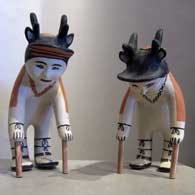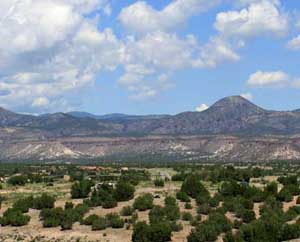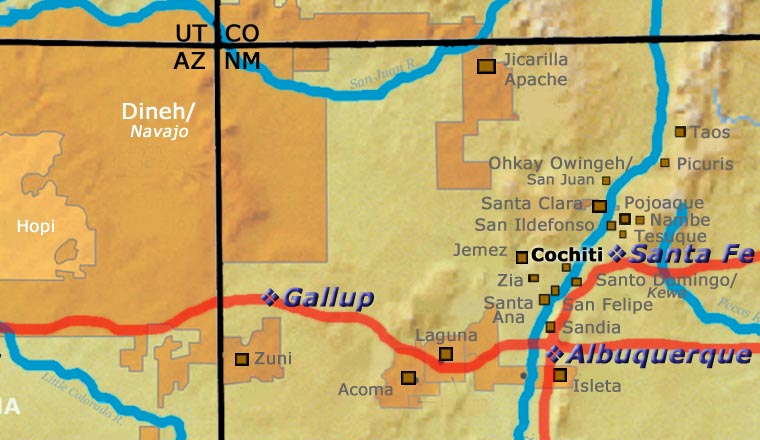
Seferina Ortiz
1931-2007
Cochiti

Cochiti Pueblo has a long history of producing figurative pottery. Among their more famous figures are storytellers: male or female figures that are usually seated and often have one or more children perched on their laps, arms, heads or backs. Seferina Ortiz was one of the most respected of the figure-making potters of her time. The Ortiz family has always shown deep respect for the traditions of their people while also exercising their individual creativity. A close-knit multi-generational family, they would often share the tasks of gathering and processing clay, and performing communal cow dung firings, the firings usually done behind Seferina's house.
Seferina's mother, Laurencita Herrera, showed her how to make pottery early in life and she continued making pottery almost until the day she died. She also passed the basics of the tradition on to her children and grandchildren. All of them became skilled at making jars, storytellers and other figures. Joyce became well known for her mermaids, nativity sets and miniature storytellers. Virgil pioneered a revival of a 19th century style of standing human figures, adding social commentary to his figures and the designs he painted on his jars. Inez also made large figures while Lisa teamed with Harlan Reano of Santo Domingo Pueblo and they became award-earning, figure-making potters, too.
Seferina said she invented the bathing beauty and mermaid figures: "When they built Cochiti Dam, all these white people were coming to swim at the lake and the lake flooded our fields, so I thought about making these (figures) with bathing suits and tails. We never had them before." When Cochiti Dam was built, the construction also destroyed the main source of Cochiti's white clay and the source where San Ildefonso and Santa Clara got the clay that turned a deep, luscious red when fired.
Seferina's work is shown in many museum and private collections. The Peabody Museum of Harvard University alone has 32 pieces of her pottery in its collection. She contributed a piece called "Cochiti Bathing Beauty" to the Smithsonian Institution exhibit of American Encounters, 1991-2004. During her life she earned numerous awards for her pottery at events such as the Santa Fe Indian Market. She signed her work: "S. Ortiz, Cochiti".
100 West San Francisco Street, Santa Fe, New Mexico 87501
(505) 986-1234 - www.andreafisherpottery.com - All Rights Reserved

Cochiti Pueblo

View west across Cochiti Pueblo
Cochiti Pueblo lies fifteen miles south of Santa Fe along the west bank of the Rio Grande. Frijoles Canyon in what is now Bandelier National Monument is the site of the pueblo's most recent ancestral home. The Eastern Keresans may have relocated to the Bandelier area from the Four Corners region around 1300.
Cochiti legend says that Clay Old Woman and Clay Old Man came to visit the Cochitis. While all the people watched, Clay Old Woman shaped a pot. Clay Old Man danced too close and kicked the pot. He rolled the clay from the broken pot into a ball, gave a piece to all the women in the village and told them never to forget to make pottery.

At Bandelier National Monument
In prehistoric times, human effigy pots, animals, duck canteens and bird shaped pitchers with beaks as spouts were common productions of the Cochiti potters. Many of these were condemned as idols and destroyed by the Franciscan priests. That problem stopped when the Spanish left in 1820 but the fantastic array of figurines created by Cochiti potters was essentially dormant until the railroad arrived. Then Cochiti potters were among the first to enter the tourist market and they produced many whimsical figures into the early 1900s. Then production followed the market into more conventional shapes.
Legend has it that a Ringling Brothers Circus train broke down near Cochiti Pueblo in the 1920s. Supposedly, the tribe's contact with the ringmaster, trapeze artists, opera singers, sideshow "freaks" and exotic animals paved the way for a variety of new figural subjects. However, shortly after the railroad passed through, a delegation of Cochiti men got on the train and traveled to Washington DC. There they were introduced to the President, spoke to Congress, and were taken on a tour of the "highlights" of American civilization in Washington and in New York City, incuding the Metropolitan Opera, the Bronx Zoo and a performance of the Ringling Brothers Circus. As none of the men could read or write, nor draw, what they brought back to Cochiti was what they remembered of things they had never seen before. The stories they told must have been wild. An astute observer will find angels, nativities, cowboys, tourist caricatures, snakes, dinosaurs, turtles, goats, two-headed opera singers, clowns, tattooed strongmen, Moorish nuns and even mermaids in the Cochiti pottery pantheon, many produced only since the early 1960s and based on characters described in Cochiti's oral history.
A few modern potters make traditional styled pots with black and red flowers, animals, clouds, lightning and geometric designs but most Cochiti pottery artists now create figurines. Most notable is the storyteller, a grandfather or grandmother figure with "babies" perched on it. Helen Cordero is credited with creating the first storyteller in 1964 to honor her grandfather. The storyteller style was quickly picked up by other pueblos and each modified the form to match their local situation (ie: clay colors and tribal and religious traditions). In some pueblos, storytellers are also now made as drummers and as a large variety of animals.
Today, Cochiti potters face the challenge of acquiring the clay for the white slip. Construction of Cochiti Dam in the 1960s destroyed their primary source of their trademark white slip and gray clay. Now the white slip comes from one dwindling source at Santo Domingo, Cochiti Pueblo's neighbor to the south.
Most outsiders who visit Cochiti Pueblo these days do so on the way to or from either the recreation area on Cochiti Lake or Kasha-Katuwe Tent Rocks National Monument.
100 West San Francisco Street, Santa Fe, New Mexico 87501
(505) 986-1234 - www.andreafisherpottery.com - All Rights Reserved

Laurencita Herrera Family Tree
Disclaimer: This "family tree" is a best effort on our part to determine who the potters are in this family and arrange them in a generational order. The general information available is questionable so we have tried to show each of these diagrams to living members of each family to get their input and approval, too. This diagram is subject to change should we get better info.
-
Laurencita Herrera (1912-1984) & Nestor Herrera
- Mary Frances Herrera (1935-1991)
- Dorothy Herrera (1969-)
- Edwin Herrera (1966-) & Mary Herrera
- Mary Ramona Herrera (1970-)
- Seferina Ortiz (1931-2007) & Guadalupe Ortiz
- Joyce Ortiz Lewis (1954-)
- Leslie Lewis
- Mary Janice Ortiz (1956-)
- Kimberly Walker (1978-)
- Juanita Inez Ortiz (1960-2008)
- Krystal Ortiz (1987-)
- Lisa Holt (1980-) & Harlan Reano (1976-)(Santo Domingo)
- Dominique Reano
- Virgil Ortiz (1969-)
- Leon Ortiz & Jackie Ortiz
- Amanda Ortiz (1988-)
- Joyce Ortiz Lewis (1954-)
Some of the above info is drawn from Southern Pueblo Pottery, 2000 Artist Biographies, by Gregory Schaaf, © 2002, Center for Indigenous Arts & Studies
Other info is derived from personal contacts with family members and through interminable searches of the Internet and cross-examination of the data found.
(505) 986-1234 - www.andreafisherpottery.com - All Rights Reserved
